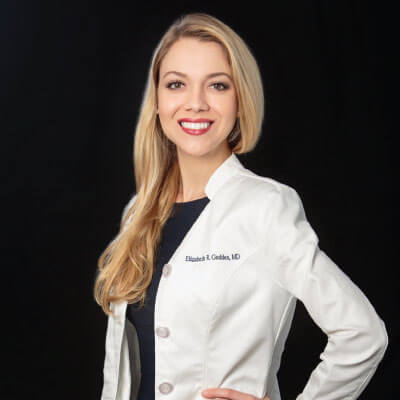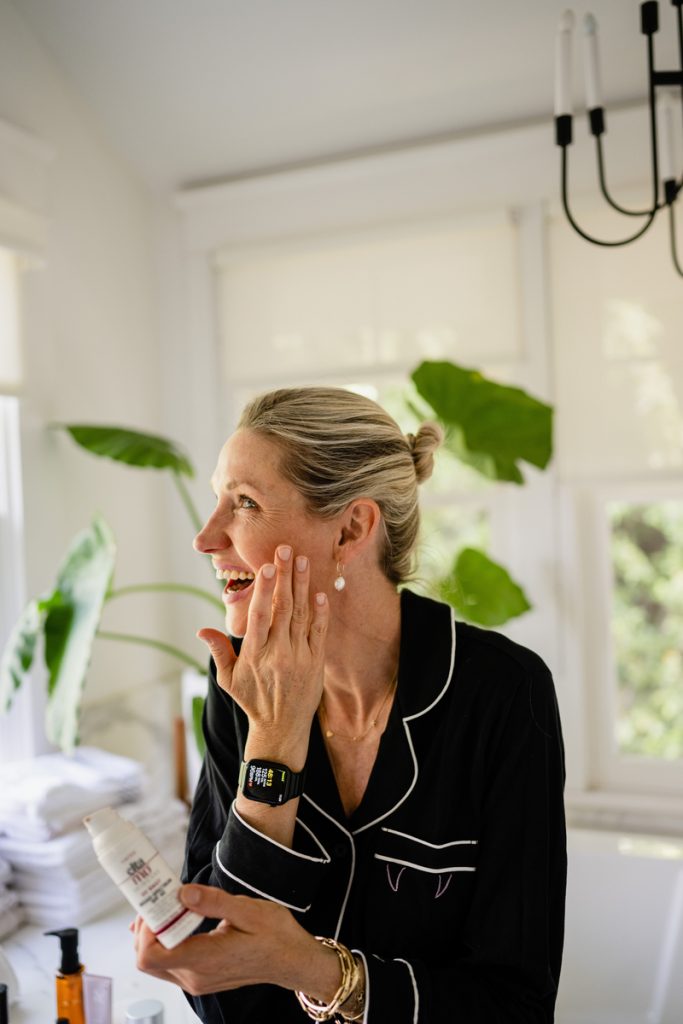All your beauty questions—answered. Our resident dermatologist, Dr. Geddes Bruce breaks down the biggest topics in beauty, from hair loss to Botox and everything in between. Send us a DM @camillestyles with your own burning q’s and we may address it in a future column.
Remember the vampire facial? It went viral because of its main ingredient: your blood. Basically, it’s a microneedling facial with added platelet-rich plasma (PRP), using the cells in your blood to speed up your skin’s healing process. But there are less dramatic ways to elevate your skin treatments—while still using your skin’s own healing powers to your advantage.
In fact, many skin-favorite products and treatments are so effective for that reason exactly, by harnessing the natural elements in your skin. Think: adding collagen to your routine (whether topically or through supplements) to help boost your natural collagen. Or how ceramides help repair your skin barrier because they’re part of what your skin microbiome is made of. And now, beauty’s buzziest facial sprays use hypochlorous acid, which is produced by your white blood cells, for targeted wound healing. And if you’re looking for the latest way to give your skin a boost, look no further. Exosomes are the latest and greatest in skin repair. Let’s explore.
Featured image above: from our interview with Sanetra Longno by Michelle Nash


Everything You Need to Know About Exosomes
My facialist has started offering exosomes as an addition to treatments. I’ve been seeing people talk about this on social media, but how do I know if using exosomes is right for me? Should I look for them in topical products or treatments? Possibly both?
Exosomes are popping up on product labels and in the treatment room. But what exactly are they? And how can they affect your skin? To get to the bottom of this new beauty buzzword, I invited Dr. Geddes-Bruce to share her insights. “Exosomes are one of the ways stem cells communicate, so it’s akin to taking pure vitamin C rather than eating an entire orange to get some,” she explained.
“Exosomes have the potential to address several skin issues like calming redness, evening skin tone, correcting brown spots, softening fine lines and wrinkles, and promoting hair growth and wound healing.”
With their potential to stimulate overall improvements in your skin by boosting its healing process, it’s no wonder exosomes are everywhere. But don’t rush into anything without asking a derm. Especially when it comes to in-office treatments, which are promising but still being studied to prove their efficacy, Dr. Geddes says.
Ahead, Dr. Geddes takes us through the ins and outs of exosomes. Prepare to discover the best, derm-approved ways to use them—and what to look out for.

Dr. Geddes is a board-certified dermatologist and dermatologic surgeon at Westlake Dermatology, specializing in the practice of both cosmetic and medical dermatology. She views cosmetic dermatology as synergistic to a happy, healthy lifestyle and regularly counsels her patients in a balanced, natural approach to both cosmetic and medical dermatology.


What are exosomes?
Think of exosomes as little bundles of information that signal the cells in your body to perform certain functions. While we traditionally think of them as coming from stem cells, exosomes are produced by all types of cells and promote different functions. For example, when you have an injury, your platelets rush to the area that needs help and send signals via exosomes to start repairing the damage.
What are exosomes used for in skincare?
Exosomes have been used and are being studied for use in topical skincare products to promote regeneration and repair. To do so, the exosomes have to be:
- safely derived (if coming from human tissue or verified blood bank sources)
- stable enough to survive in a bottle on your bathroom counter
- actually effective in their claims, without the potential to do any harm


Are exosomes FDA-approved?
Our FDA does an incredibly thorough job of regulating drugs and any claim of a product to treat disease falls under the purview of the FDA. There are currently no FDA-approved exosome products and any practice offering injectable exosomes to treat conditions with claims of improving disease should be approached with extreme caution.
It’s the Wild West out there with unregulated claims and cowboy practitioners, so always inquire about safety, efficacy, and tread with caution into this new field of regenerative medicine. Let the studies prove safety and efficacy before jumping on this bandwagon, despite the potential exciting effects. There is a particular brand of topical exosomes that I feel confident recommending to my patients called ( plated ).
Who can benefit from exosomes?
Anyone who sees the effects of aging or skin damage from pollution, sun damage, or generally not taking good care of yourself can likely see benefits from topical exosomes.


How long do exosomes take to work on the skin?
Most topical skin products start working immediately, but it takes time to visualize the transformation. I would recommend giving a six-week trial for all of your skincare products, including topical exosomes, as long as they aren’t irritating your skin.
Are there disadvantages of exosomes?
Exosomes are a novel product and therefore can be quite expensive. Before investing in this type of skincare, make sure to look for products with high-quality published data and rigorous safety standards. Make sure you understand that these products have the potential to influence the way cells work, and therefore their cell source is an important consideration in their safety. On the flip side, you also want to make sure you are using a product that is shelf-stable at room temperature so that you get what you paid for.






